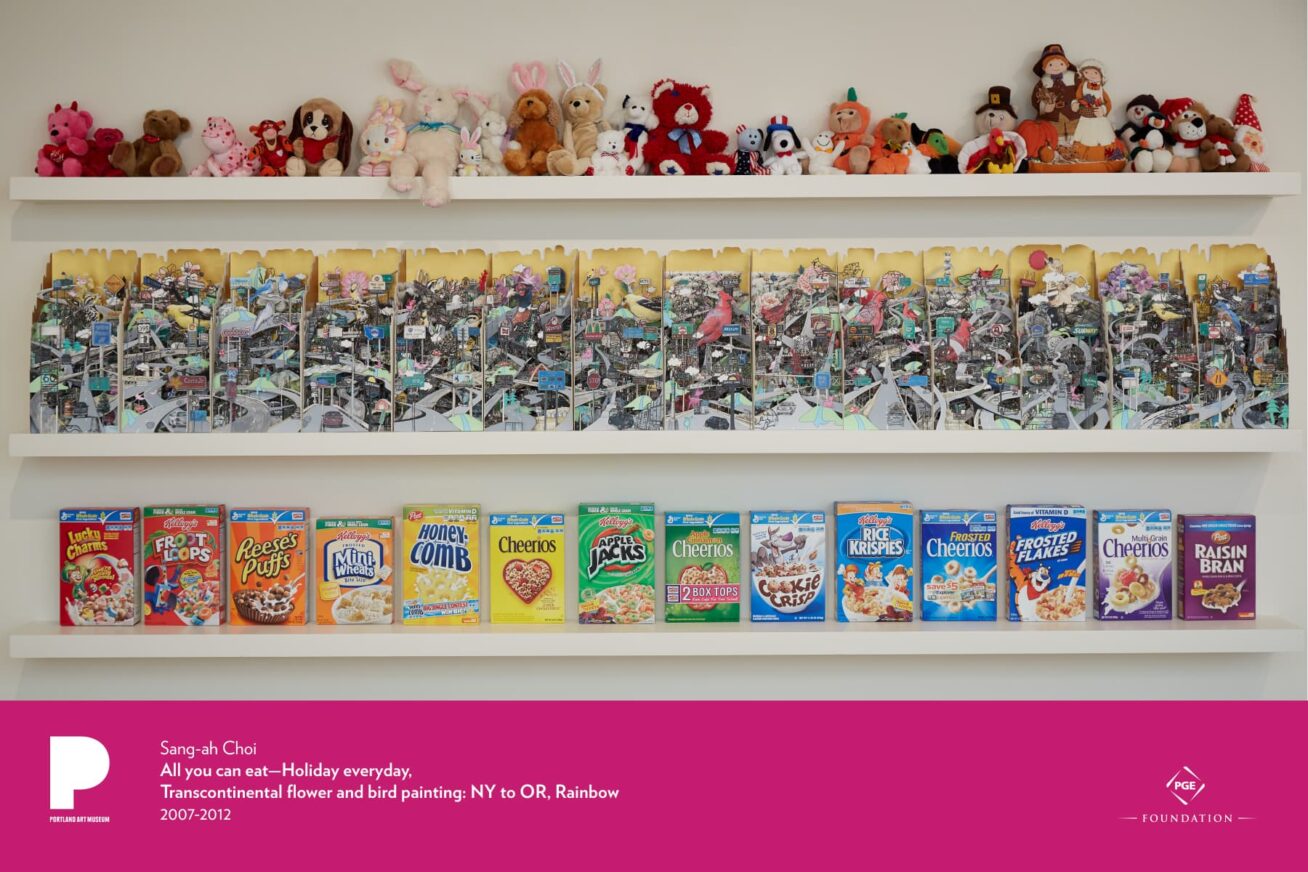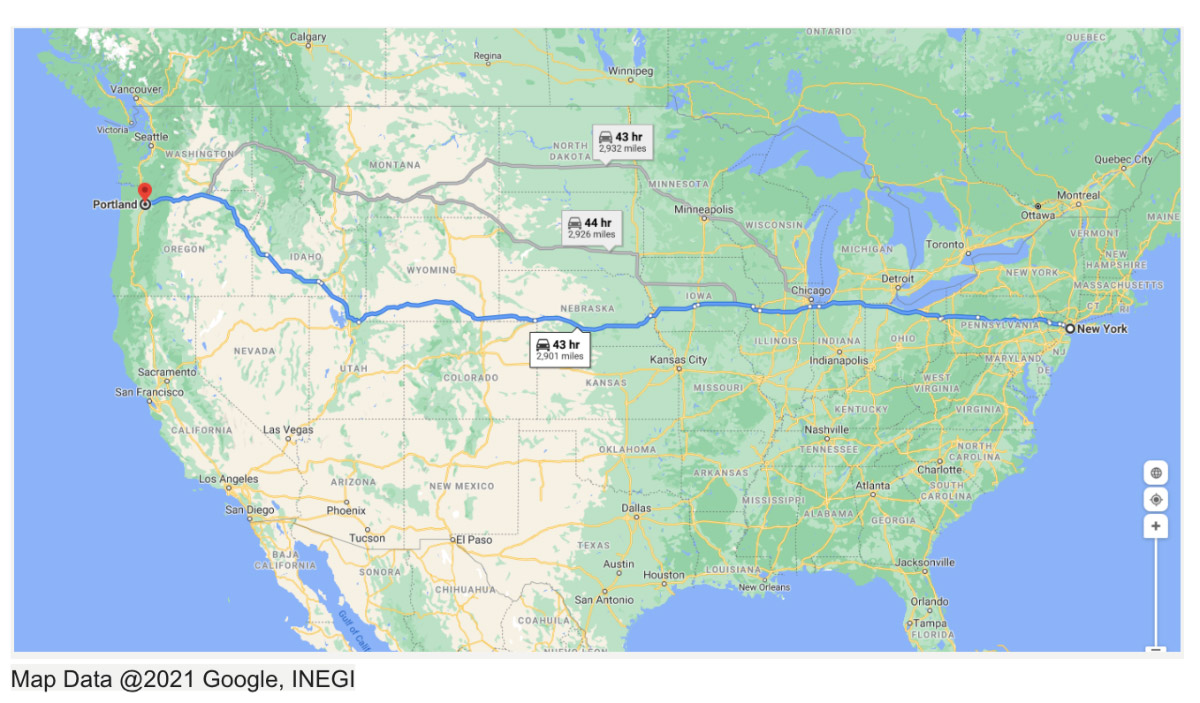
Sang-ah Choi’s installation All you can eat—Holiday everyday, Transcontinental flower and bird painting: NY to OR, Rainbow (2012) chronicles the artist’s road trip across the U.S. from New York to Oregon. Choi was born in South Korea, and the artist’s installation reflects the dissonance she experienced as she travelled through an American landscape defined by consumption and excess.
“Being a foreigner in a different culture was an overwhelming yet exciting experience for me,” Choi writes. “At first, I thought the language was the only challenge since I felt that I had been exposed to American pop culture in Korea throughout my upbringing. But soon, I realized the cultural ramp up is a long process—knowing it is not the same as living it.”
The All you can eat installation includes three shelves. The top shelf, Holiday everyday, displays an arrangement of stuffed animals and plush toys lined up in chronological order from the first holiday of the year to the last. The reds and pinks of Valentine’s Day transition to pastel bunnies for Easter, oranges and browns for the fall holidays of Halloween and Thanksgiving. The shelf concludes with animals wearing red and white scarves and pointy red hats for Christmas. For many of us visiting grocery stores and malls, the rotating displays for upcoming holidays seem ever present, perhaps provoking excited anticipation, but also serving as a disquieting reminder of cultural and monetary expectations that can be challenging to meet.
The lower shelf, Rainbow, displays another colorful spectrum, this time formed from boxes of cereals organized in rainbow colors, beginning with red Lucky Charms and ending with purple Raisin Bran. Our grocery store aisles are dedicated to the jewel- like and sweet-as-candy breakfast cereals. People who grew up eating American cereal often express nostalgia for their childhood favorites, but for someone newly arrived in the country, coming from a different culture, the devotion to cereal brands may feel strange and unfamiliar.
The middle shelf, Transcontinental flower and bird painting: NY to OR, presents a more complicated and layered expression of this cultural disparity. Intricately and densely installed, each pop-up diorama, inspired by the boxiness of a McDonald’s Happy Meal package, is exquisitely detailed, chronicling Choi’s road trip. Studying AAA’s TripTik booklet for navigation, Choi observed that each state is represented by a state bird and flower. Inspired by Korean traditional bird-and-flower paintings, Choi carries this theme throughout the entire piece. The mundane moments along the actual road trip itself are illustrated in a landscape of highways, motels, chain restaurants, gas stations, and repetitive road signs.
Across this diorama, Choi incorporates the traditional Korean imagery of Ship-jangsaeng (십장생, Ten Symbols of Longevity). Originally a Daoist expression of the wish for a long and healthy life, the Ten Symbols are drawn from nature: sun, mountain, cloud, water, rock/stone, crane, deer, turtle, mushroom, and pine tree. These motifs, shown in cartoon-like illustrations, weave playfully throughout the entire panoramic scene. For this diorama, Choi explains, “I borrowed the format of these traditional utopian Korean landscape paintings and juxtaposed it with contemporary American cultural symbols and imagery, weaving them via a traveller’s perspective.”
Sang-ah Choi lives and works in Mountain View, California.
Discussion and activities
- Why do you think the artist Sang-ah Choi chose to take everyday objects and make them into art? How does her choice of objects—cereal boxes, holiday stuffed animals, McDonald’s Happy Meals, highway signs—reflect her impression of America? What objects do you see as emblematic of U.S. culture?
- Look closely at the cut paper work on the middle shelf. What things and creatures do you see represented? What patterns or repetitions do you notice? How does Choi weave together themes and iconography from both U.S. and Korean cultures?
- Think about this work as a representation of a landscape. How does Choi convey the passage of time as well as movement through space? What relationships does she suggest between nature and built environments? How does this work compare to other landscape works in the Poster Project, such as Utagawa Hiroshige’s Fukagawa Susaki and Jūmantsubo, Wendy Red Star’s Indian Summer, and Charles Heaney’s Mountains? What difference does it make that Choi’s work is three-dimensional?
- Imagine that Choi’s work had a soundtrack. What would it be?
- Have you ever taken a road trip or moved from one place to another? Write down five things that you remember about that experience. Who were you with on your journey? What did you do while you were in the car? What did you notice about the landscape that you passed through? How did it feel to be in transition?
- Make a collage of your favorite cereals or breakfast foods—either by using the discarded packaging or by taking a picture of the products—and write an artist statement to share why these foods are your favorite. Do they represent your unique preferences or are they representative of American or other cultures?
- In this work, Sang-ah Choi eloquently weaves together themes and imagery from both U.S. and Korean cultures. Think about two cultures that you are familiar with. (They don’t necessarily have to be different nationalities.) What themes and imagery would you use to create a diorama like hers? Make a short video (TikTok style) bringing together the two cultures.
Recommended resources
- Sang-ah Choi
- Artist Talk: Sabina Haque. Portland Art Museum. January 17, 2019.
- Ten Longevity Symbols, 18th century, Korea. Philadelphia Museum of Art.
- Ten Symbols of Longevity (十長生圖, 십장생도, Shipjangsaengdo). 1879-80. Korea. Jordan Schnitzer Museum of Art.
- Contemplating Nature: Chinese and Korean Bird-and-Flower Paintings. Harvard Art Museums. June 4, 2015 – November 29, 2015.
- From New York City to Portland, Oregon

Spanish-language PDFs developed with the support and collaboration of
